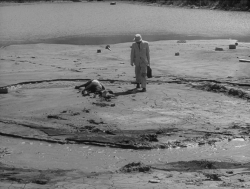Reviews
Joel Coen
USA, 2001
Credits
Review by Michael Nordine
Posted on 16 November 2010
Source Universal DVD
In what is perhaps the strangest exchange in The Man Who Wasn’t There, barber Ed Crane muses to his brother-in-law Frank:
This hair, you ever wonder about it? It keeps on coming, it just keeps growing. It’s part of us, and we cut it off and throw it away.
He has learned, we find out later through voice-over narration, that human hair keeps growing for a short while after death, and so he wonders: might this be evidence of the soul? And, if we cut it off, what then happens to that soul? “I’m gonna take this hair and throw it out on the dirt,” he says next. “I’m gonna mingle it with common house dirt.” Frank - who owns the barber shop at which Ed works - is a decidedly less curious individual (both in terms of his own inquisitiveness and the extent to which one need wonder about him), and the sentiment is lost on him.
This scene, along with many others in the film, illustrates the extent to which Ed is out of place—not only in his own workplace, but in the world into which he has been thrust. That this is done in such a seemingly bizarre way may be best attributed to the fact that this is, after all, a neo-noir by the Coen Brothers. Even calling Ed a barber needs qualification, as he rejects the title: “Yeah, I worked in a barber shop,” he tells us, “but I never considered myself a barber.” (One must later wonder, after he kills a man, whether he considers himself a murderer.) These lines, which open the film, are our first clue toward understanding Ed’s deep-seated dissatisfaction with life, an inherent ennui from which his every subsequent action springs forth. Ed’s refusal to accept his lot in life is perhaps his defining characteristic, as well as his undoing.
Unlike most of the films in the Coens’ oeuvre, The Man Who Wasn’t There is neither screwball nor relentlessly grim. It is instead their most subtly engrossing film, advanced as it is by a deepening sense of the lost soul that Ed so fundamentally is. But it does share a principal commonality with the rest of the Coens’ body of work in Roger Deakins’ cinematography. Shot in black-and-white, the visuals are both a throwback to the Noir movies that influenced the film and a facility between form and content: Ed’s internal landscape is as monochromatic and cold as the grayscale world in which he lives. Seen through Deakins’ lens, 1950s Santa Rosa, California appears as an unfolding dreamscape rather than the idyllic small town it may well have been. Yet for all its starkness, the look of the film is nothing if not even-keeled. Fittingly, Ed relates his story with a laconism that betrays his emotional distance—what few words he offers us hint at a longing for something other than the hand he’s been dealt. Yet, by his own admission, he hasn’t played these cards especially well. The question of what his true problem is - his environment or himself - is thus muddled, impossible to answer clearly.
Take, for instance, dry cleaning, “the wave of the future,” as it were. Ed hears about it for the first time from an entrepreneur named Creighton Tolliver (that his name sounds like “cretin” is probably no coincidence) and later tries to wrap his mind around the concept. Initially unable to decide whether it sounds like a hoax or a genuine prospect, he eventually decides to invest in it and become part of something new before it passes him by. As with Albert Camus’ The Stranger, whose narrative structure The Man Who Wasn’t There closely resembles, Ed’s turning point comes when he becomes an active participant in his own life for the first time. Spectator no longer, his actions only serve to worsen his situation. And, like Meursault in that novel, Ed’s downfall is twofold: he lives in a world that has no place for him, and his efforts to deal with this sad fact are ill-advised and poorly executed. His eventual fate is thus both inevitable and self-enabled.
Ed is able to find solace only in the piano-playing of a teenager named Birdie, the daughter of a man whose hair he used to cut. It is here, against the quiet backdrop of Beethoven’s sonatas, that Ed’s life unravels. Suffice to say that everything that can go wrong does, though not in a way that elicits much sympathy for Ed. Doubtless this has much to do with Ed’s own lack of self-pity and emotion. His plight is that of a specimen to be observed from afar, rather than a fellow human to know and fully understand. That, too, is part of his tragedy, for, as his own lawyer argues, “the more you look, the less you really know.” Ed’s problem isn’t so much that he isn’t there but that, when you finally catch a glimpse of him, there’s no way to be sure exactly what has caught your gaze.
A UFO motif is woven into The Man Who Wasn’t There as the final statement on Ed’s otherworldly status. Near the end of the film, he has a vision - or is it real? - of one such spacecraft. The vessel hovers above him, shines a near-blinding white light in his eyes, then flies away silently. Too alien for this world, yet human, all too human for theirs, Ed exists in an unreachable state beyond any rescue, especially from himself.
We don’t do comments anymore, but you may contact us here or find us on Twitter or Facebook.



